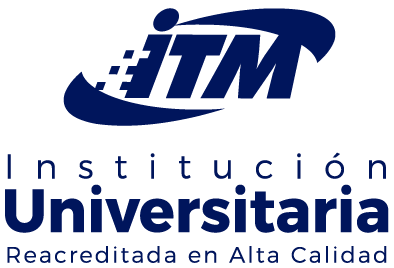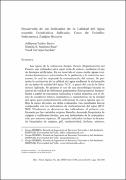Mostrar el registro sencillo del ítem
Desarrollo de un indicador de la calidad del agua usando estadística aplicada, caso de estudio: Subcuenca Zanjón Oscuro
| dc.contributor.author | Valdes-Basto, Jefferson | |
| dc.contributor.author | Samboni-Ruiz, Natalia E. | |
| dc.contributor.author | Carvajal-Escobar, Yesid | |
| dc.date.accessioned | 2019-07-18T14:10:12Z | |
| dc.date.accessioned | 2019-08-16T16:39:47Z | |
| dc.date.available | 2019-07-18T14:10:12Z | |
| dc.date.available | 2019-08-16T16:39:47Z | |
| dc.date.issued | 2011-06-21 | |
| dc.identifier | https://revistas.itm.edu.co/index.php/tecnologicas/article/view/60 | |
| dc.identifier | 10.22430/22565337.60 | |
| dc.identifier.uri | http://hdl.handle.net/20.500.12622/870 | |
| dc.description.abstract | Las aguas de la subcuenca Zanjón Oscuro (Departamento del Cauca), son utilizadas para regar caña de azúcar, mediante el uso de drenajes artificiales. En su recorrido el cauce recibe aguas residuales domésticas e industriales de la población y la industria azucarera, lo cual ha originado la contaminación del mismo. Se presenta la evaluación de la calidad del agua mediante la elaboración de un índice de calidad del agua “ICA”, a partir del uso de la Estadística Aplicada. Se propone el uso de una metodología basada en curvas de calidad de diferentes parámetros fisicoquímicos desarrollados a partir de encuestas realizadas a varios expertos, con el objeto de establecer límites cualitativos y cuantitativos de la calidad del agua; para posteriormente seleccionar la curva óptima que refleje la mejor decisión, en dicha evaluación. Los resultados fueron comparados con los indicadores de contaminación del agua (ICOMO). Finalmente se obtuvieron dos indicadores: el primero conformado por las variables oxígeno disuelto, demanda bioquímica de oxígeno y coliformes fecales, que son indicadores de la contaminación por materia orgánica. El segundo indicador incluye la demanda bioquímica de oxígeno, pH, conductividad, fosfatos, nitratos, turbiedad y sólidos totales, que permiten una evaluación general de la calidad del agua. | spa |
| dc.format.mimetype | application/pdf | |
| dc.language.iso | spa | |
| dc.publisher | Instituto Tecnológico Metropolitano (ITM) | spa |
| dc.relation | https://revistas.itm.edu.co/index.php/tecnologicas/article/view/60/98 | |
| dc.rights | Copyright (c) 2017 Tecno Lógicas | spa |
| dc.source | 2256-5337 | |
| dc.source | 0123-7799 | |
| dc.source | TecnoLógicas; Num. 26 (2011); 165-180 | eng |
| dc.source | TecnoLógicas; Num. 26 (2011); 165-180 | spa |
| dc.subject | Índice de calidad del agua (ICA) | spa |
| dc.subject | contaminación del agua | spa |
| dc.subject | estadística aplicada | spa |
| dc.subject | curvas de valoración | spa |
| dc.title | Desarrollo de un indicador de la calidad del agua usando estadística aplicada, caso de estudio: Subcuenca Zanjón Oscuro | spa |
| dc.title.alternative | Desarrollo de un indicador de la calidad del agua usando estadística aplicada, caso de estudio: Subcuenca Zanjón Oscuro | |
| dc.subject.keywords | Index of quality of water (IWQ) | eng |
| dc.subject.keywords | contamination of the water | eng |
| dc.subject.keywords | applied statistic | eng |
| dc.subject.keywords | rating curves | eng |
| dc.type | info:eu-repo/semantics/article | |
| dc.type | info:eu-repo/semantics/publishedVersion | |
| dc.type | Articles | eng |
| dc.type | Artículos | spa |
| dc.relation.ispartofjournal | TecnoLógicas | |
| dc.description.abstractenglish | The waters of the subriver basin Zanjón Oscuro, located in the plains of northern Cauca, Cauca Department, are used for irrigation of sugar cane by the use of artificial drainages. In its course the stream receives domestic and industrial sewage from the population and the sugar industry, which has led to pollution of it. This paper presents the work the evaluation of the quality of the water by means of the elaboration of water quality index “WQI”, from the use of the Applied Statistic. For this aim the use of a methodology based on the elaboration of curves of quality of different physicochemical parameters sets out that they were developed from a realised survey to different experts, with the intention of establishing qualitative and quantitative limits of the quality of the water; later to select the optimal curve that reflects the best decision to evaluate the quality of the water. The results were compared with the indicators of contamination of the water. Obtaining like result two indicators, the first conformed by the variables dissolved oxygen, biochemical demand of oxygen and faecal coliforms, which are indicating of the contamination by organic matter. The second includes the biochemical demand of oxygen, pH, conductivity, phosphates, nitrates, turbidity and total solids, which allow a general evaluation of the quality of the water. | eng |
| dc.rights.accessrights | info:eu-repo/semantics/openAccess | |
| dc.type.coar | http://purl.org/coar/resource_type/c_6501 |
Ficheros en el ítem
Este ítem aparece en la(s) siguiente(s) colección(ones)
-
Num. 26 (2011) [12]


